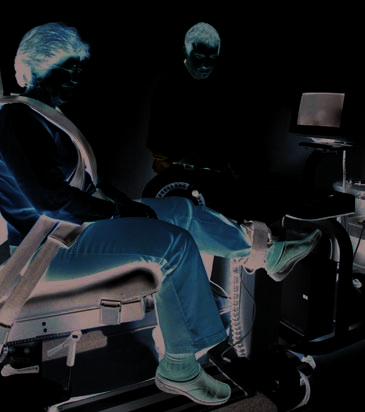


healthY
aging
Lessons from the
Baltimore Longitudinal Study of Aging
NatioNal iNstitute oN agiNg
NatioNal iNstitutes of HealtH
u.s. DePaRtMeNt of HealtH & HuMaN seRViCes




Contents
FOReWORD 1
Why StuDy Aging? 5
WhAt DOeS All thiS MeAn FOR yOu? 15
BlSA’S IDEAL FutuRe 25
tAking StOck, lOOking AheAD 27
BiBliOgRAphy 28

Foreword
Just like millions of Americans, the National Institute on Aging’s
(NIA) Baltimore Longitudinal Study of Aging (BLSA) celebrates
its 50th birthday in 2008. The study was the first to ask a most
basic question: What is normal aging?
There is still much to learn, but so far two major conclusions
can be drawn from BLSA data. First, “normal” aging can be
distinguished from disease. Although people’s bodies change and
can in some ways decline over time, these changes do not inevit-
ably lead to diseases such as diabetes, hypertension, or dementia.
A number of disorders that typically occur in old age are a result
of disease processes, not normal aging.
Second, no single, chronological timetable of human aging exists.
We all age differently. In fact, in terms of change and development,
there are more differences among older people than among
younger people. Genetics, lifestyle, and disease processes affect
the rate of aging between and within all individuals.
1



These fundamental changes in our thinking about age and disease
have led the BLSA and the field of aging research in important new
directions. As we further pinpoint the influences on how we age,
we can also think about new and more effective interventions that
may prevent disease and promote healthy aging.
This booklet was developed to celebrate the 50th anniversary of
the BLSA and the wealth of data and insights it has given us. It
also provides an occasion to share some of what we know about
aging and aging well from a large body of research, including the
BLSA. As you read through this booklet, we hope you will find it
useful in thinking about your own aging and steps you can take
that might make a difference for maintaining your health.
We dedicate this booklet to the thousands of BLSA volunteer study
participants, scientists, and support staff who have joined in a unique and sustained research enterprise over five decades. Their
partnership has been a gift that benefits us all.
Richard J. Hodes, M.D.
Dan L. Longo, M.D.
Luigi Ferrucci, M.D., Ph.D.
Director
Scientific Director, 1995 –2010
Director, Baltimore Longitudinal
National Institute on Aging
National Institute on Aging
Study of Aging
National Institutes of Health
National Institutes of Health
National Institute on Aging
National Institutes of Health
2





about the national institute on aging
The National Institute on Aging (NIA), part of the National Institutes of Health, was established to improve the health and well-being of older people through research. As part of its mission, the NIA investigates ways to support healthy aging and prevent or delay the onset of diseases disproportionately affecting older adults. NIA’s research program covers a broad range of areas, from the study of basic cellular changes with age to the examination of the biomedical, social, and behavioral aspects of age-related conditions. Although the main purpose of this research is to increase “active life expectancy” — the number of years free of disability — it may also promote longevity.
3



I N T H E I R O W N W O R D S : R E F L E c T I O N S F R O M T H E B L S A S T A F F
Studying aging processes and discovering
dr. luigi FerruCCi solutions that can reduce the burden of
disease and disability on older people has been the dream of my life. I started to pursue a career as a geriatrician and a gerontologist in Florence, Italy, in my early twenties when almost every exciting discovery about aging began at the BLSA. At that time, I confess that while my friends were idealizing rock stars and soccer players, Nathan Shock was my hero.
So, you can imagine that when I moved to the U.S. in 2002 to become the new director of the Baltimore Longitudinal Study of Aging, I was proud,
Of special joy are enthusiastic, and extremely frightened. Since then, my dedication and attachment to the BLSA has grown steadily and
the connections I’ve
my fear has faded. I work with a team of committed, bright,
made with the BLSA creative, and hard-working scientists, nurses, health workers, participants who and administrators. Of special joy are the connections I’ve are the true soul made with the BLSA participants who are the true soul of the study. Listening to their stories, capturing the multi-of the study.
faceted aspects of their lives, and understanding their prob-
lems has taught me more about aging than reading any number of books or articles. I could never find words beautiful enough to thank each participant properly. I will not even try.
However, I promise that their effort and their generosity will be fruitful, that everyone associated with the BLSA will work to produce the best possible science,
and that we all are committed to translating these findings into actions to improve the quality of life for older people.
4


Dorothy broke open her fortune cookie and read
its contents: “May you live a long, healthy life.”
Who doesn’t hope for longevity combined with
good health in later years?
whY studY aging?
The Beginning of Something New—
The Baltimore Longitudinal Study of Aging
For the most comprehensive and longest
same people over time. He hypothesized that
running longitudinal examination of human
important concepts pertinent to aging could
aging in the world, NIA’s Baltimore Longitudinal
only be understood by looking at healthy,
Study of Aging (BLSA) had a simple beginning.
independently living people at regular intervals
It started with a conversation in 1958 between
over a number of years. Shock didn’t just want
Nathan Shock, Ph.D., Chief of the Gerontology
bodies donated to study aging after death; he
Branch at the National Institutes of Health
wanted living people participating in scientific
(NIH), and William W. Peter, M.D., a retired
studies. This was a radical concept that intrigued
U.S. Public Health Service officer and missionary
Peter. He volunteered to be the first participant.
doctor. Peter had a long-established reputation
Soon, Shock and Peter were joined by study
for his dedication to medicine and wanted to
coordinator Arthur Norris, described by Shock
know how he could make a final contribution
as his “steady right hand.” The three men
— donating his body to science. But Shock had
outlined the new study’s parameters. The BLSA
something else in mind. He wanted to discuss
would “observe and document the physical,
the direction he believed aging research should
mental, and emotional effects of the aging
take. Breaking with scientific convention,
process in healthy, active people.” Women were
Shock wanted to study normal aging, and he
not originally part of the study design, but
wanted to do it by repeatedly evaluating the
joined the BLSA in 1978, offering scientists
5


the opportunity to better understand the
instance, as scientists investigate bone density
influence of sex on aging, especially important
changes over time, participants learn how their
because at the time women lived 8 to 9 years
individual risk for fractures from these changes
longer than men. Many of the original female
may fluctuate with age.
participants were wives or widows of male
volunteers.
As the BLSA answers many of its original
questions about aging, scientists are
Currently, NIA’s Intramural Research Program
formulating new ones. Keeping in step with
in Baltimore welcomes more than a thousand
emerging research interests, the study has
male and female BLSA participants ranging in
turned its attention to increasingly prevalent
age from their twenties to nineties, who come
health issues such as obesity, loss of muscle
every 2 years for a variety of tests to help
mass and strength (sarcopenia), disability,
scientists observe changes over years of life.
and cognitive disorders. For example, in 1993,
Participants receive a complete physical exam
BLSA investigators began a 9-year study using
and tests of mobility, body composition, muscle
brain scans to learn if cognitive changes, like
strength, bone density and geometry, cardio-
visual memory and mental skills, can be
respiratory function, nervous system anatomy
related to structural changes in the brain.
and function, glucose metabolism, inflammation,
They discovered that, over time, even very
hormones, and more. Like pioneer participant
healthy older adults lose a significant amount
Peter, volunteers often say they are proud
of brain volume as part of normal aging. By
of their contribution to science. Along with
introducing new areas of study and continually
personal gratification, another benefit to BLSA
evolving, the BLSA maintains a steadfast
participants is learning about their health. For
influence on health research.
Below: Gerontology Research Center dedication in 1968
6







Left: Nathan Shock, Ph.D.
Above (top left): William W. Peter, M.D.
Above (top right): Arthur Norris
Above: Nathan Shock, Ph.D., in clinical setting, 1953
7



8

Designing a Different Look at Aging and Time
The BLSA’s longitudinal design helps investigators piece together a more accurate picture of normal aging. Before the BLSA, scientists generally conducted cross-sectional studies, comparing participants in one age group to a different set of people in another age group. Most of the differences between these groups may not have been attributed to age but the result of life experiences, genetics, or environmental factors. Imagine comparing two people, one who has lived through two wars and the other who was raised in a peaceful and prosperous society. How each aged might be different but the effect of age alone would be difficult to sort out. By looking at the same individuals over time, external influences are reduced. Longitudinal research allows scientists to gather thousands of case studies of human aging.
What Is Normal Aging?
True to Shock’s vision, the BLSA still looks
also noted that hearing
for answers to the question, “What is normal
sensitivity declines
aging?” This may seem like a simple question,
earlier and faster
but for scientists, it gets to the heart of some-
in men than
thing quite complex: how to identify the true
in women.
effects of aging and how to separate factors
such as disease, socioeconomic disadvantage,
By studying normal aging, scientists
or lack of educational opportunity from the
disproved certain stereotypes associated
underlying biological or other mechanisms
with older adults. For instance, have you
common to human aging.
ever heard the myth that people become
meaner as they get older? By analyzing
The study of normal aging has helped change
long-term personality data, BLSA scientists
our understanding of what it means to grow
learned, in fact, that an adult’s personality
older. Although, for the most part, people age
generally doesn’t change much after age 30.
differently, scientists have identified certain
People who are cheerful and assertive when
common changes experienced by nearly
they are 30 will likely be the same when they
everyone. For example, BLSA scientists
are 80. This research finding runs contrary to
observed that people who have no evidence of
the popular belief that people naturally become
hearing disorders or noise-induced hearing
cranky, depressed, and withdrawn as they age.
loss still lose some of their hearing with age —
The finding suggests that marked changes in
that’s normal — but the pattern of this loss
personality are not due to normal aging, but
varies from person to person. The scientists
instead may be related to disease or dementia.
9

What Are the Links Between
in turn, accelerate arterial aging. Given this
Aging and Disease?
correlation, scientists realized that they could
not study the normal aging heart without
To study normal aging, BLSA scientists
considering heart disease. And, by studying the
originally attempted to cut out all diseases from
two together, they would be better equipped to
their research. They found, as predicted, that
identify strategies to prevent or slow arterial
“normal” aging is not synonymous with disease.
aging before cardiovascular disease occurred.
But they also found that the two were probably
not independent either. Because research is an
BLSA’s longitudinal design supports the
iterative, cascading process, the answers to
pursuit of links between aging and disease.
“What is normal aging?” led scientists to the
Scientists can look back at information
question, “What is the relationship between
collected from participants over time,
aging and disease?” It is well established that
including data from years before a diagnosis,
the risk of developing many diseases increases
and attempt to identify the changes that
with age. One of the BLSA’s biggest contribu-
precede and perhaps predict clinical symptoms,
tions to biomedical science is its ability to
the so-called precursors of disease. They can
investigate this relationship.
determine what distinguishes two seemingly
healthy people: one who will go on to develop a
In this vein, the BLSA is changing our under-
certain health problem, the other who will not.
standing of cardiovascular disease. Scientists
looking at the aging heart found that age-related
The discovery of the relationship between
changes in the arteries, like arterial stiffening,
prostate-specific antigen levels, or PSA levels,
do increase the risk for cardiovascular diseases.
and prostate cancer illustrates the value of this
They also found that cardiovascular diseases,
“retro spective.” While the medical community
knew that the PSA enzyme tended to be elevated
among men with prostate cancer, definitive
information about the rate of this change in
precancerous men was unknown. In 1991,
BLSA researchers analyzed blood samples
collected over a period of years from 54 men
in the study (18 already diagnosed with
prostate cancer), to see how the PSA levels
changed over time. This small early study
revealed there was a rapid rise in PSA levels
about 5 years before the prostate cancer was
diagnosed. The men without cancer, including
those with benign prostate growth or hyper-
plasia, did not have this rapid rise in PSA
levels. BLSA researchers also observed that the
rate of PSA change is a more sensitive method
of detecting prostate cancer than using
10


a fixed cutoff value. Furthermore, scientists
used by scientists to create a history map for
determined that examining the ratio of free
the time preceding a participant’s diagnosis
PSA (not attached to a protein) to total PSA
of AD. These maps showed when participants
helps reduce incorrect diagnosis; moreover,
experienced an accelerated decline in memory,
the percentage of free PSA in the blood can
verbal intelligence, and executive function (the
predict the aggressiveness of prostate cancer
ability to use past experiences to carry out
a decade before diagnosis.
cognitive actions like correctly categorizing
animals, fruits, and vegetables or identifying
The unique opportunity to look back at the
and recalling important details). In 2008,
participant’s clinical history also benefitted
BLSA scientists reported that almost everyone
research on dementia. BLSA measurements
experienced a steady rate of natural decline in
of cognition — the ability to think, learn, and
their cognitive abilities. However, the rate of
remember — began in 1960. Scientists were
decline among people who went onto develop
then looking for natural changes with age.
AD varied over time. Memory decline, for
In 1985, the focus shifted to distinguishing
example, increased (compared to normal)
normal cognitive decline from decline
approximately 7 years before the AD diagnosis
associated with dementias like Alzheimer’s
and then accelerated a second time 2 to 3 years
disease (AD). BLSA’s longitudinal data was
before diagnosis.
11
11



I N T H E I R O W N W O R D S : R E F L E c T I O N S F R O M T H E B L S A S T A F F
I have been with the BLSA since May 2001 as
KATY SWANSON
a Geriatric Nurse Practitioner. I’m responsible
for overall clinical assessment and evaluation, which means that I collect history information and obtain consent from BLSA participants, do their physical exams, and explain BLSA test results. By being part of the BLSA team, I have grown in my clinical expertise and learned so much about the research process. I feel the atmosphere at the BLSA is invigorating and stimulates me to continue in this professional role. Each of
The participants are us working on this study is made to feel we are an integral part and so important in achieving the goals of the BLSA.
one of the primary
reasons I stay with When I was first hired to work with the BLSA, I planned on a 2-year commitment and then I thought I’d return to
the study. Their
oncology nursing. Yet, I am still here. The participants are
continued dedication one of the primary reasons I stay with the study. Their and commitment are continued dedication and commitment are so impressive.
so impressive. Many of them have more than 20 visits (that’s over 40 years), all on a voluntary basis. I have had the opportunity to
develop friendships with many participants. They set the standard for my motivation to stay healthy. Without the participants, there would be no study. There is no way that we can adequately thank them for their continued contribution.
12


Overall, by incorporating the study of disease
circumference improved the predictive
into their understanding of normal aging,
power of BMI for coronary risk in younger
BLSA scientists have been able to:
but not older people.
n Quantify certain areas of natural, age-
n Track trends for behaviors that promote
related decline and compare these
health or risk for disease. In one BLSA
declines with changes related to disease.
study, scientists examined the dietary
For instance, researchers have studied
diaries of participants ages 27 to 88 from
natural versus disease-related changes in
1961 to 1987 to see how food choices
muscle quantity and strength, how these
changed over time. They found that in













































